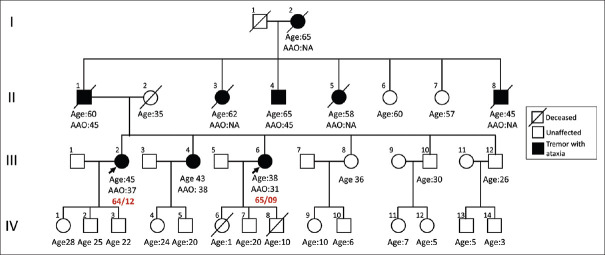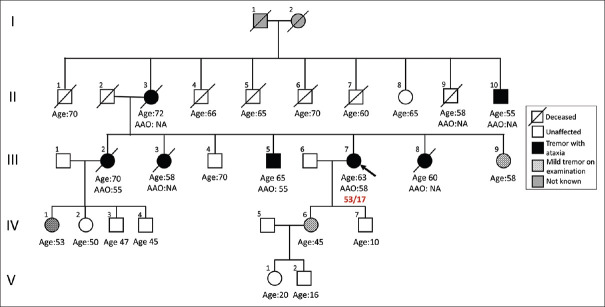Sir,
Spinocerebellar ataxia type-12 (SCA12) is an autosomal dominant cerebellar ataxia (ADCA) which occurs due to a CAG triple repeat expansion in the gene encoding protein phosphatase-2 regulatory subunit-Bβ (PPP2R2B).[1,2] It was first reported in an American family of German descent.[3] The prevalence of SCA12 outside of India is low and has been described from United states of America,[3] China,[4] France,[5] Italy,[6] and Singapore.[7] Cases reported so far from India predominantly belong to an endogamous ethnic group which originates from north India.[1,2] We report three cases from two families of SCA12 from a different ethnicity, originating from South India.
FAMILY-1
A 45-year-old female [Figure 1, III-2] presented with an eight-year history of chronic progressive tremulousness of bilateral upper limbs (UL), which was predominantly postural, worse during activity, less at rest and absent during sleep. Additionally, slurring of speech and imbalance while walking was noted for three years prior to presentation. She was ambulant and independent for activities of daily living (ADL) at the time of presentation. Multiple members of her family were affected with a similar illness [Figure 1]. There was no other significant history.
Figure 1.
Pedigree chart of family 1 (Age in years, AAO: Age at onset)
On examination, she had normal cognition, horizontal gaze-evoked nystagmus, saccadic pursuit, ocular dysmetria and ataxic speech. There was bilateral UL postural tremor, with an intentional component. Additionally, there was tremor of head, voice and tongue, with truncal titubation. She had appendicular and axial cerebellar ataxia, and her International Co-operative ataxia rating scale (ICARS) score was 51/100. Rest of her neurological examination was normal.
A 38-year-old female [Figure 1, III-6], the younger sibling of case-1, presented with a similar history of postural and action predominant tremulousness of bilateral UL and head for the past seven years and mild slurring of speech with imbalance while walking for three years. At presentation, she was ambulant and independent for her ADLs. Apart from the positive family history, there was no other significant history [Figure 1]. Examination findings were identical to case 1 with an ICARS score of 53/100.
Magnetic resonance imaging (MRI) of brain showed diffuse cerebellar atrophy in both the cases. In view of the chronic progressive ADCA, genetic testing in the form of SCA panel by fragment analysis was performed for SCA1, 2, 3, 6, 7, 12, 17 in case-1. A heterozygous expanded CAG repeat length of 64 repeats (Normal range 4-32) with 13 repeats in minor allele was noted in PPP2R2B gene confirming the diagnosis of SCA12. Testing for SCA12 in case-2 revealed a heterozygous expanded repeat length of 65 repeats with minor allele carrying nine repeats. Their family belonged to an ethnicity originating from Karnataka, which is in the southern part of India. The family was counselled regarding the illness and was managed with symptomatic treatment.
FAMILY-2
A 63-year-old female [Figure 2, III-7], presented with a five-year history of action predominant tremulousness of UL. There was history of mild slurring of speech and imbalance while walking for two years. At presentation she was ambulant and independent for ADLs. There was history of a similar illness in her family [Figure 2]. She was a diabetic and hypertensive, and there was no other relevant medical history. Video was taken after written informed consent.
Figure 2.
Pedigree chart of family 2 (Age in years, AAO: Age at onset)
On examination [Video 1], she had normal cognition, saccadic pursuit, ocular dysmetria and ataxic speech. There was mild postural tremor with intentional component in bilateral UL. Both appendicular and axial cerebellar ataxia was noted with an ICARS score of 26/100. Deep tendon reflexes were brisk in all four limbs with bilateral extensor plantar response and impaired vibration and joint position sense in bilateral feet. Other neurological and systemic examinations were normal.
MRI of brain showed diffuse cerebellar atrophy. Fragment analysis for SCA panel (SCA1, 2, 3, 6, 7, 12, 17) revealed a heterozygous expanded CAG repeat length of 53 repeats with 17 repeats in minor allele in the PPP2R2B gene confirming the diagnosis of SCA12. Similar to the first family, her family also originated from south India, from the state of Tamil Nadu. Family was counselled regarding the illness and was managed with symptomatic treatment. This case has been previously reported by us as part of a separate study.[8]
SCA12 classically presents with postural tremor of UL as the first symptom. In comparison to other SCAs, ataxia is less severe and occurs at a later stage of disease. As the disease progresses, there can be tremor of head, voice, trunk, and lower limbs. Neuropsychiatric symptoms, pyramidal and extrapyramidal involvement, and peripheral neuropathy have also been reported in a few cases. The vast majority of SCA12 cases reported from India, belong to an endogamous Agrawal ethnic group, and a common founder mutation has been implicated.[1,2] The combination of a tremor dominant ADCA and ethnicity from the Agrawal community is often highly suggestive of SCA12. Although uncommon, there are reports of SCA12 from India belonging to different ethnicities. Srivastava et al. reported a different ethnicity in 5-8% of their cases with SCA12.[9] Similarly, one out of 12 families reported by Sinha et al.[10] had a different ethnic background and one out of 21 families reported by Choudhury et al.[1] originated from eastern India with a different ethnicity. All 3 cases described in our report were from a different ethnicity, with origins from south India. Case-1 and case-2 had otherwise typical manifestations of SCA12, whereas case-3 had ataxia, pyramidal signs with mild action tremor. SCA12 should be considered in cases of tremor dominant ADCA or essential tremor like presentation even when they belong to another ethnicity.
SCA12 should be suspected in any case of tremor predominant ADCA irrespective of the ethnicity.
What is known:
Spinocerebellar ataxia type 12 (SCA12) is a tremor dominant autosomal dominant cerebellar ataxia commonly identified in India. Majority of the cases reported so far belong to an endogamous ethnicity originating from North India.
What is New:
SCA12 is not restricted to a particular ethnicity and can be seen in other ethnicities as well. The present report describes two families of SCA12 from ethnicities originating from South India.
Declaration of patient consent
The authors certify that they have obtained all appropriate patient consent forms. In the form the patient(s) has/have given his/her/their consent for his/her/their images and other clinical information to be reported in the journal. The patients understand that their names and initials will not be published and due efforts will be made to conceal their identity, but anonymity cannot be guaranteed.
Financial support and sponsorship
Nil.
Conflicts of interest
There are no conflicts of interest.
Video available on: www.annalsofian.org
REFERENCES
- 1.Choudhury S, Chatterjee S, Chatterjee K, Banerjee R, Humby J, Mondal B, et al. Clinical characterization of genetically diagnosed cases of spinocerebellar ataxia type 12 from India. Mov Disord Clin Prac. 2018;5:39–46. doi: 10.1002/mdc3.12551. [DOI] [PMC free article] [PubMed] [Google Scholar]
- 2.Bahl S, Virdi K, Mittal U, Sachdeva MP, Kalla AK, Holmes SE, et al. Evidence of a common founder for SCA12 in the Indian population. Ann Hum Genet. 2005;69:528–34. doi: 10.1046/j.1529-8817.2005.00173.x. [DOI] [PubMed] [Google Scholar]
- 3.Holmes SE, O'Hearn EE, McInnis MG, Gorelick-Feldman DA, Kleiderlein JJ, Callahan C, et al. Expansion of a novel CAG trinucleotide repeat in the 5′ region of PPP2R2B is associated with SCA12. Nat Genet. 1999;23:391–2. doi: 10.1038/70493. [DOI] [PubMed] [Google Scholar]
- 4.Dong Y, Wu JJ, Wu ZY. Identification of 46 CAG repeats within PPP2R2B as probably the shortest pathogenic allele for SCA12. Parkinsonism Relat Disord. 2015;21:398–401. doi: 10.1016/j.parkreldis.2015.01.006. [DOI] [PubMed] [Google Scholar]
- 5.Cintra VP, Lourenco CM, Marques SE, de Oliveira LM, Tumas V, Marques W., Jr Mutational screening of 320 Brazilian patients with autosomal dominant spinocerebellar ataxia. J Neurol Sci. 2014;347:375–9. doi: 10.1016/j.jns.2014.10.036. [DOI] [PubMed] [Google Scholar]
- 6.Brussino A, Graziano C, Giobbe D, Ferrone M, Dragone E, Arduino C, et al. Spinocerebellar ataxia type 12 identified in two Italian families may mimic sporadic ataxia. Mov Disord. 2010;25:1269–73. doi: 10.1002/mds.22835. [DOI] [PubMed] [Google Scholar]
- 7.Zhao Y, Tan EK, Law HY, Yoon CS, Wong MC, Ng I. Prevalence and ethnic differences of autosomal-dominant cerebellar ataxia in Singapore. Clin Genet. 2002;62:478–81. doi: 10.1034/j.1399-0004.2002.620610.x. [DOI] [PubMed] [Google Scholar]
- 8.Venkatesh SD, Kandasamy M, Moily NS, Vaidyanathan R, Kota LN, Adhikarla S, et al. Genetic testing for clinically suspected spinocerebellar ataxias: Report from a tertiary referral centre in India. J Genet. 2018;97:219–24. [PubMed] [Google Scholar]
- 9.Srivastava AK, Takkar A, Garg A, Faruq M. Clinical behaviour of spinocerebellar ataxia type 12 and intermediate length abnormal CAG repeats in PPP2R2B. Brain. 2017;140:27–36. doi: 10.1093/brain/aww269. [DOI] [PubMed] [Google Scholar]
- 10.Sinha KK, Sudhir R, Jha DK. Spinocerebellar ataxia type 12 is not an uncommon form of ADCA in India. Ann Indian Acad Neurol. 2003;6:193. [Google Scholar]
Associated Data
This section collects any data citations, data availability statements, or supplementary materials included in this article.




